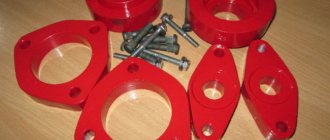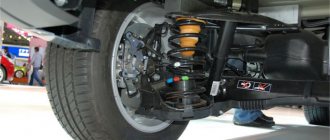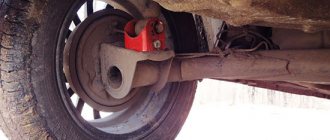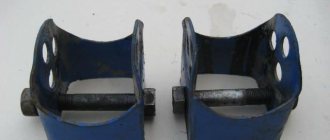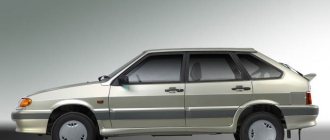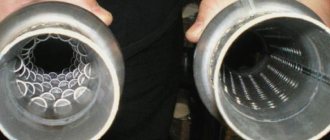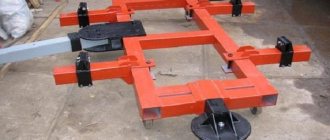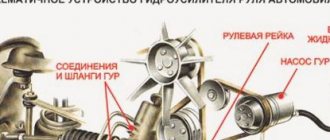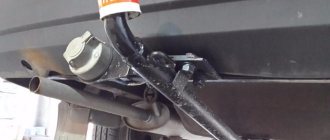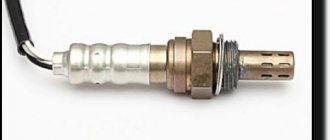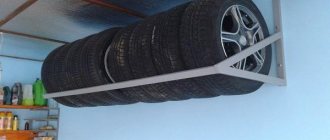On Russian roads there are special requirements for vehicle permits. Therefore, production cars often lose bumpers or mufflers, or have a puncture in the gearbox or crankcase. After reading the article, you will learn how to increase the vehicle's ground clearance using spacers, how to install them yourself and what consequences this will bring.
Types of spacers
On cars with MacPherson strut suspension, spacers made of plastic, rubber, polyurethane or aluminum are often used to increase the distance between the shock absorber strut and the body. These spacers are installed on both the front and rear suspension. Other types of front suspension use rubber spacers to increase the distance between the spring and the lower control arm.
Sometimes, if you need to increase the ground clearance by 4-6 cm, the same spacer is installed between the spring and the upper suspension arm. The rear spring suspension of front-wheel drive cars uses a house-type strut. The rear spring suspension of rear-wheel drive vehicles uses the same spacers as the front one, which increases the distance between the spring and the axle or body. Sometimes rubber (polyurethane) spacers are used, which are inserted between the coils of the spring. These spacers significantly increase the spring rate and therefore reduce ride comfort.
Characteristics of spacers made of various materials
Online stores sell spacers of various types, shapes and sizes. In some cases, finding suitable spacers is quite difficult and you need to make them yourself, for which you need to clearly understand how a particular material affects the car. This will help you choose the optimal material for the spacer. Aluminum spacers have good strength, but cause corrosion to the body and strut. Plastic and fiberglass spacers are as strong as aluminum ones, but do not cause engine damage. But it is very difficult to remake them.
If the mounting holes of the spacer and rack bolts do not line up, drilling additional holes will reduce their strength. Polyurethane gaskets have good durability, but they must be selected carefully. If the spacer is at least 1mm larger than the seat, it will be very difficult to install. Rubber gaskets have less resistance than polyurethane gaskets. Their duration is 2-3 times less and rarely exceeds 30 thousand kilometers.
Consequences of installing spacers
The only advantage that the use of spacers gives is accompanied by a considerable number of disadvantages, here are the main ones:
- changing the angle of attack (the angle of inclination of the front shock absorber) impairs the maneuverability of the car;
- an increase in the rotation angle of the CV joint (CV joint, “grenade”) leads to a sharp acceleration of its wear and a reduction in mileage by 2-5 times;
- increasing the distance from the control point to the axis of a rear-wheel drive vehicle, which increases wear on the driveshaft support bearing;
- changes in wheel camber and toe-in, resulting in increased fuel consumption and tire wear, and decreased handling;
- problems with passing technical inspection and insurance company. Installing spacers is a modification to the vehicle design that is prohibited by the Road Traffic Regulations. Consequently, there is a high probability of denial of insurance compensation after an accident.
How to install spacers on a car with your own hands + Video
To install spacers you will need an elevator, overpass or inspection pit. If none of this is available, you can get by with a jack and two support posts. You will also need a set of wrenches and a suspension spring remover. The procedure for installing spacers on various types of suspension is described below. Before starting work, carefully read the article on the safety of car repairs and maintenance, this will help you avoid injuries and injuries.
Installation of spacers on MacPherson suspension
- We unscrew the CV joint nut, then suspend the front part of the car with a lift or jacks and supports and remove the wheels. If the decorative cap touches the CV joint nut, remove one wheel without lifting the other side of the front of the car. Ask an assistant to engage first gear (you do not need to start the engine) and fully depress the brake pedal. Then do the same operation on the other side.
- Remove the cotter pin and unscrew the nut securing the tie rod pin in the shock absorber strut. If for some reason the nut does not come out, turn the steering wheel in the opposite direction. After unscrewing the nut, remove the pin from the strut using a puller, which can be purchased at any auto store. Do not try to finger tap with a hammer as this will damage the threads and the entire tie rod end will have to be replaced. Unscrew the ball joint nut, press the lower arm down and remove the steering knuckle from it. Place a wheel or other support under the strut; this will allow you to install the spacer without removing the brake caliper.
- Remove the nuts that secure the shock absorber to the car body. Do not drop the riser as this may damage the brake hose. Carefully lower the strut until the main bearing studs come out of the housing. Then position the riser so that there are no deformations or kinks in the brake hose. Install the spacer onto the support bearing and tighten the nuts. For spacers 1 cm thick, there is no need to tighten the nuts.
- Carefully lift the bearing until the main bearing studs fit into their holes. Tighten the nuts. Do not use nuts with plastic inside; they will not secure the spacer rod sufficiently. Therefore, use two regular metal nuts. If the studs are not tall enough to tighten the two nuts, sand one of the nuts down to half thickness and use it as a locknut. Place the steering knuckle onto the CV joint shaft. Have a helper step on the brake pedal and tighten the CV joint nut to the torque specified in your vehicle's repair manual, then be sure to tighten the nut with a hammer and chisel.
- Reinstall the tie rod end, tighten the nut, and install the cotter pin. Insert the ball joint into the lower arm and tighten the nut. Install the wheels and tighten the wheel nuts or bolts. Lower the vehicle to the ground and tighten the wheel nuts or bolts. Adjust camber and toe. You can do this at any car service center or yourself.
Installing a spacer on the front multi-link suspension
Suspend the front of the car and remove the wheels. Unscrew the lower part of the shock absorber from the lower control arm. Using an extractor, compress the springs so that the distance from them to the shoulder cup is at least twice the thickness of the spacers. Lift the spring and insert the lower spacer. Then install the top brace. Loosen the puller until the spring snaps into place, then remove it completely. Attach the lower part of the shock absorber, install the wheels in place and adjust the camber and toe. This procedure applies to any type of front-wheel drive or rear-wheel drive multi-link vehicle.
Installation of a “house” spacer on the rear axle of a front-wheel drive car
Shift into first gear, loosen the rear wheel bolts and raise the rear of the car. Remove the wheels and place something under the control arm. Unscrew the nut from the bolt connecting the lower part of the shock absorber to the lever. Pull the lever down and screw the “house” to the shock absorber. Lift the lever and screw in the spacer with a new bolt and nut. Tighten all nuts to the torque recommended in your vehicle repair manual (may vary from vehicle to vehicle). Install the wheels.
How to install spacers on rear spring suspension
Raise the rear of the car and remove the wheels. Compress the springs with a puller as described above. Install the lower brace and, if necessary, the upper brace. Remove the extractor and replace the wheels.
Many motorists tune their cars. Upgrades can be made to almost any part of the car. Painting and tinting are not limited to. One of the ways to improve the quality performance of a car is to increase the ground clearance - body height.
Clearance
Ground clearance is the distance between the ground and the lowest point of the car. Amateurs measure ground clearance from the edge of the body. But there are a lot of protruding parts on the bottom of the car. The lowest point of the car is under the engine, which is protected by a metal or plastic “skirt”. It is from this that you need to measure the distance from the ground in order to accurately determine the distance.
Foreign cars are often greatly undervalued. It looks nice, but it’s better not to crush the car’s belly on Russian roads. And off-road you need to drive at least 200 mm. Ground clearance has also increased on older cars that have noticeably lower springs.
Each group of cars has its own optimal ground clearance:
- passenger car - 140-200 mm;
- SUV - 180-250 mm;
- SUV - 200-350 mm.
Having measured the ground clearance of his iron horse and remaining dissatisfied, the motorist begins to improve it by increasing the height of the car.
What are spring spacers and what are they for?
Spring spacers are additional units installed on the vehicle. The task of these units is to increase the ground clearance between the vehicle and the road surface, which differs from the factory parameters. The reason for installing spacers is most often the dissatisfaction of car owners with these factory parameters.
If you own a car with minimal ground clearance, then every trip outside the city can turn into trouble for you. The point here is not even in such characteristics as fuel consumption, engine power and range, but also in such characteristics as, for example, ground clearance.
In most cases, when going on a country trip, you will encounter at least one section of the road that has poor road surface. If your car is not raised enough from the road surface, you can easily damage the body or even get stuck on even small obstacles. Unfortunately, on some roads only the BMP-3 can pass at all, but increasing the gap between the lower part of the body and the road is sometimes not superfluous.
Most SUVs and crossovers are designed this way. Their main task is to confidently drive on dirt roads, damaged paved roads and in conditions where there is no pavement. This is achieved, among other things, thanks to this “elevation” of the body above the surface.
In various adverse weather conditions, such as rain, river floods, falling branches and snowfalls, the movement of a vehicle with minimal clearance may be difficult. Such cars will not be able to overcome some difficult sections of roads, even in urban conditions, where special services sometimes cannot cope with the pressure of the elements.
If you want to understand whether your car needs an increase in ground clearance, you should calculate it. Ground clearance is the minimum distance between the lowest point of the car body and the road surface. Due to the numerous protrusions and small parts at the bottom of the car, finding this very point may take some time. However, most often the lowest point is directly under the engine. When calculating ground clearance, also take into account the protection under the engine in the form of a metal or plastic skirt, evenly located under the power unit. The most unpleasant thing in this situation is that the plastic skirt that the car received as standard will not be able to fully protect the engine from breakdown, but it will also take away some distance from the road surface. We have to put up with it.
When checking the clearance with the manufacturer, remember that he will give you the value without taking this protection into account.
So, the purpose of spacers is to increase ground clearance. To do this, they are installed under the springs or at the place where the shock absorber and car body are attached. The installation of such spacers is most often justified when it is necessary to increase the natural ground clearance, the value of which has decreased during the operation of the vehicle. Such changes are suitable for car owners who often travel by car off-road or on poor-quality surfaces.
How to increase clearance yourself
The distance can be increased on its own. Most often, special devices are used for this - spacers.
Selection of materials
Spacers to increase the overall dimensions of a car are made from the following materials:
Each material has its own advantages and disadvantages.
Rubber spacers
- resistant to external influences in the form of acid, salt, alkali;
- they do not affect the car’s maneuverability and comfort in the cabin;
- they do not have a corrosive effect on the body;
- they are cheap in the car market.
- rapid wear;
- subject to deformation and damage.
Rubber gaskets are secured under the springs.
Polyurethane spacers
In addition to the benefits of rubber, they also have:
- increased resistance;
- withstands significant loads without breaking;
- Capable of absorbing impacts on uneven road surfaces.
The disadvantages include:
- high pressure on the bushings;
- possibility of body deformation.
These spacers are also suitable for installation under springs. They are more expensive than rubber ones, but cheaper than metal ones.
Aluminum spacers
All of the above advantages of other materials are more pronounced in aluminum spacers. They also do not wear out for a long time.
The only significant drawback is the possibility of corrosion on the body. They are usually mounted at the junction of the shock absorbers with the car.
ABS plastic
Currently, it is the most acceptable gasket material on the automotive market. It has all the advantages of previous models, but without their disadvantages.
Plastic spacers are placed under the springs.
Installing spacers on the front of the car
Installation of spacers in front of the machine is carried out in accordance with the following instructions:
- The car is jacked up and the wheel is removed.
- Disconnect the brake hoses and unscrew a couple of nuts from the front strut, after tightening the springs with a clamp.
- The support is removed by unscrewing the nuts from the upper support.
- Old bolts are replaced with new ones of longer length.
- The gasket is screwed on and assembled in the reverse order. If there is interference from the crossbar, it is supported by a second jack.
- All the same actions are repeated with the second wheel.
Installing rear spacers
Installation of spacers on the rear of the car is carried out according to the following instructions:
- The thresholds of the rear doors of the car and under the trunk lid are removed.
- The rear seats extend as far forward as possible. The lining is removed from the barrel and side walls, completely exposing the body.
- Jack up the car from behind with a jack and remove the wheel.
- Tighten the nuts at the top and bottom and remove the holder.
- Old bolts are replaced with new ones of longer length.
- Attach the spacer to the bolts and reassemble in reverse order.
Main rules when installing spacers
There are a few things to keep in mind when installing spacers:
- metal spacers must be subjected to anti-corrosion treatment;
- if a passenger car has front-wheel drive, it should not rise above 20 mm;
- in 80% of cases it is desirable to install spacers both above and below the synchronizing spring;
- when installing spacers on the backrest, it is necessary to take into account the angle of the car (it is better not to raise it more than 30 mm);
- if the play increases by more than 30 mm, problems with car alignment may occur;
- Bolts and studs of the correct size must be supplied with spacers.
What material is better to use
Before making spacers, you need to select the material from which future products will be made. Of course, this issue has already been discussed earlier, but the use of plastic spacers is not limited only to the upper part of the spring.
In the front part of the machine, it is recommended to use metal products that will not damage the levers and will work well under heavy loads . For the rear part, it is recommended to use plastic, which will absorb all impacts and vibrations without destruction. Moreover, in the event of an accidental break or deflection, they will not cause damage to the metal parts of the suspension.
It is strongly recommended not to install polyurethane spacers on the body side. The problem is that they have a metal base that comes out when the product wears out quickly. If this base comes into contact with the body, there is a risk of accidental damage to it due to uneven road surfaces.
Rubber spacers are susceptible to tearing and deformation, but they are low cost, making them a good temporary alternative.
You can find out how to install them in special manuals for repairing the suspension of your car, since this process is individual due to the characteristics of different designs.
Disadvantages of tuning
Increased ground clearance also has disadvantages:
- the load on the carriage increases;
- poor machine stability on ice;
- a shift in the center of gravity leads to deterioration in maneuverability;
- wear of steering system elements accelerates;
- Toe camber imbalance occurs.
If the car owner is not a car expert, he is more likely to damage the car by installing spacers himself. In this case, it is better to entrust the increase in height from the ground to professionals.
What does increasing clearance lead to?
Regardless of the purpose for which you plan to install spacers, you need to be aware of the consequences that you will have to face.
- Buying new shock absorbers. The fact is that the standard length of these elements is designed for the strict length of standard springs, which means that when the height of the car increases, the length of a conventional shock absorber will not be enough and it will simply “break”.
- After making such changes to the suspension, it is necessary to do a wheel alignment. An experienced driver knows that after any intervention in the suspension, for further operation of the car it will be necessary to re-adjust it.
- The last reason why you may not want to increase the ground clearance is a deterioration in handling. A shift in the center of gravity causes the car to behave poorly when turning the steering wheel at high speed. This is especially true for trucks, which are most prone to rollovers.
Other methods for increasing ground clearance
In addition to installing spacers, motorists know other ways to increase the free space of a vehicle:
- Increase your wheel size.
- Replacing shock absorbers and springs.
Increasing wheel size
To increase ground clearance, larger wheels are installed on the car. This is fraught with some problems:
- the speedometer will show the wrong speed because it is based on the number of wheel revolutions;
- wheels that are too large will stick to the fender liners and interfere with driving;
- Larger wheels will change the diameter of the disc, which will lead to accelerated tire wear.
Replacing shock absorbers and springs
You can increase ground clearance by replacing shock absorbers and springs with longer ones. This method has some disadvantages:
- the cost of parts is much higher than the cost of spacers;
- replacing these elements is a very complex and time-consuming task, and when contacting a specialist it is expensive;
- Changing these major parts will void the warranty if the machine is new.
Results
The structure of a car requires complete balance of all its parts. If you make any changes, you can break it badly. If you need to use the car in poor background power conditions, it is worth choosing a suitable car model. If you need to increase ground clearance, you need to correctly calculate all the details.
Do-it-yourself spacers for increasing ground clearance are one of the simplest and cheapest ways to solve the problem of the bottom of the car catching on uneven roads and increasing cross-country ability.
But how much they can help, what their advantages and disadvantages are, is worth understanding in more detail.
Purpose of spacers for springs
As already mentioned, potholes and bumps haunt the domestic car enthusiast almost everywhere. It is no coincidence that the official spacer for foreign cars includes an increase in ground clearance. Very often this is not enough. Why, even domestic cars with their considerable ground clearance reach their bottoms to the ground. Therefore, for Russia, high ground clearance will always be relevant. There are many situations when increasing it is necessary. But the most vital ones are:
- constant contact of the bottom or crankcase protection with the road, especially when driving on ruts;
- falling into a hole with the front wheels, when the front of the car, loaded with the engine, nosedives and the springs, completely closing, transfer all the impact energy to the body;
- when the trunk is fully or excessively loaded, the rear part of the car sags greatly, on bumps the wheels cling to the fender liners, and with a long rear overhang, the rear part of the exhaust pipe hits the ground.
Over time, the springs wear out and are not able to effectively absorb vibrations and loads.
Therefore, the front or rear of the car sags even without load. Installing spacers is one of the easiest and cheapest ways to increase ride height or stiffen springs without replacing them. Anyone can do this for a small amount of money.
The problem of insufficient clearance
Many owners of passenger cars during operation are faced with a problem - the car’s low ground clearance, due to which, when overcoming bumps, the car clings to the bottom until it hangs on its “belly”. This is especially noticeable in winter.
In addition, the problem with insufficient height can arise both with a new car, in which a small ground clearance is structurally provided (such cars are usually called “puzoterka”), and with models with a tolerance, in general, quite acceptable, but due to the spring suspension it happened decrease.
So, what driver doesn’t want to bring his car at least a little closer to crossovers and SUVs in cross-country ability.
And the easiest way is to increase the ground clearance.
How to choose and use
- Don't buy tabs secondhand. Stable suspension requires good factory parts. Otherwise, the purchase may damage the car.
- Please note: the buffer must be suitable for your specific car model. Pay attention to the list in the official instructions. Select autobuffers according to car sizes and models.
- To select the maximum clearance, measure the current clearance and find the standard in the reference book. Subtract the smaller value from the larger one and add 50mm.
- Increase the ground clearance at the rear and front at the same time - this will help improve the car's handling.
- Every winter and summer, check the condition of the parts, change them if necessary. Pay attention to the features of a particular type of inlay - iron takes a long time to deteriorate, and polyurethane quickly.
Ways to increase clearance
There are several ways to increase ground clearance; when choosing the best, you should take into account the problem being solved: increasing ground clearance to increase cross-country ability or eliminate the consequences of a withered spring.
One of the easiest ways to increase ground clearance is to install larger diameter wheels on your car. This solution can really help add a couple of inches between the bottom and the road.
But there are many negative aspects: installing such wheels will be expensive, the play will increase, but the distance between the wheel and the arch will decrease, and the load on the suspension and transmission will increase. In general, this method is not the most optimal.
It is possible to increase the stiffness of the tensioned springs, thereby reducing body vibrations when driving over uneven surfaces, not only by replacing them (which is not always cheap), but also by installing elastic elements between the coils of the spring.
Their main task is to resist compression. Previously, ordinary tennis balls were used for these purposes (and now for some this setting is quite relevant).
Now you can simply buy special rubber gaskets that are installed between the coils. This modification of the suspension only increases the stiffness of the springs and has virtually no effect on ground clearance.
You can also increase the ground clearance by completely reworking the chassis and installing air suspension instead of the usual ones. But this is a very expensive option.
Installing spacers is the easiest way to increase both ride height and spring rate.
You don’t need to change anything in the car’s suspension; they are cheap or you can make and install them yourself.
The essence of this method is to add special pads under the shock absorbers between the body and the support (increases ground clearance) or between the support and the spring (increases stiffness).
everything is simple: the spacer will not allow the shock absorber to fully unfold (rest against the body), as a result, the supporting part will rise relative to the wheel, thereby increasing ground clearance.
As for spacers to increase rigidity, after installing the strut the spring will be in a more compressed state.
Big wheels
This is a rather expensive method, but at the same time simple to implement. You can do it yourself without any problems, as it is as simple as possible. Your task is to buy other wheels and tires of a larger diameter and install them.
For example, you can easily increase the ground clearance by removing your 15th wheels and installing 16th ones, respectively, installing the same tires. But be careful, take tires with the same profile as it was. The fact is that if it is less, then the ground clearance will either not change, or, on the contrary, will decrease.
Look at what wheel sizes are suitable for your car, as if they don't match, problems will arise. When turning, the wheels can touch the arches, thereby damaging the tires and the arch itself, which is not particularly encouraging.
You also get an improvement in appearance, but that's a plus. The speedometer will display a lower speed, and the vehicle's mileage will be lower according to the instruments than in reality. In addition, dynamics and maximum speed will decrease, and consumption will increase. The fact is that wheels with a larger diameter are simply heavier. But these changes will not be particularly big.
Most cars will allow this method to increase their ground clearance by a maximum of 3 centimeters. This is not so much, but maybe someone needs it, plus they wanted new wheels.
What are spacers made of?
Manufacturers of auto parts and accessories have already noticed that spacers are in demand, so they have already started producing them.
In addition, different materials are used for their manufacture:
Polyurethane and rubber are elastic materials by nature, so they can shrink during operation, which allows them to better dampen vibrations.
At the same time, polyurethane is very resistant to negative environmental influences, so it can last a long time.
But the design of such spacers often uses metal bushings in the bolt holes, and this is their disadvantage.
When compressed, these bushings come into contact with the body, and corrosion may appear at the points of contact.
Although rubber is subject to “aging,” such gaskets do not contain metal elements, so they do not have a negative effect on the body.
On a Suzuki Escudo it looks like this:
Aluminum gaskets are very durable, but since they are metal, corrosion can occur where they contact the housing.
Plastic is better in this regard. It is also durable but will not rust. Therefore, spacers made of rubber and plastic are optimal for installation on cars.
It should also be noted that it is advisable to use spacers made of durable materials on the front suspension, and elastic ones on the rear suspension.
Also, you cannot endlessly increase the space with the help of spacers.
Their thickness should not exceed 3-5 cm; the use of thicker substrates will lead to a significant deterioration in vehicle handling.
Advantages and disadvantages
If we consider the positive aspects of using spacers to increase ground clearance, in general there are not so many of them:
- Increased vehicle maneuverability;
- Increase spring stiffness;
- Increase the carrying capacity of the car (when loading the car does not fold so much);
- The likelihood of damage to the underbody of the vehicle is reduced.
There are many more disadvantages to such a suspension setup, so you should think carefully about whether it is worth installing them.
Car suspension spacers are:
- Reduced vehicle stability on the road due to a change in the center of gravity;
- Increased wear of truck components;
- Increased load on transmission joints (in front-wheel drive vehicles);
- Change the task to fail as a whole (becomes more difficult);
- Deterioration in controllability.
But here it is worth noting that with the right approach to the problem of installing spacers, the negative impacts will be minimal and almost unnoticeable.
Installation algorithm
Installing spacers to increase ground clearance (if they fit between the strut support and the body) is not difficult and can be done with your own hands.
Below is the general sequence of work for installing them. It fits almost any car, but it should be borne in mind that each model has its own specific nuances.
To install spacers in front you need:
- Unscrew the wheel and remove it from the car;
- Disconnect the levers and steering tips from the rack;
- Unscrew the nuts securing the strut to the body;
- Lower the stand and turn it so that there is access to the upper support;
- We remove the “original” bolts from the support (knock them out), put elongated ones in their place (so that the bolts do not turn when tightening the nuts, it is better to weld them to the support);
- We put a spacer on the bolts;
- Place the holder in place and secure it with nuts;
- Let's put everything in its place.
Then the operation is repeated on the other side. After installing the spacers, you need to adjust the camber angles.
The underlays are installed on the rear suspension in much the same way. That is, we disconnect the stand from the body, change the bolts, install a spacer, and put everything in place.
The only thing is that after installation work, adjustment of the angles is not required.
But this describes the installation of spacers on passenger cars, which are mainly used in front of MacPherson struts.
But there are also machines that have a different design, so supports are often installed under the springs. All this is shown more clearly below.
Front installation procedure
How to install spacers to increase ground clearance in the front part of the body? To do this, follow the recommendations:
- We lift the car with a jack, remove the tire, disconnect the braking system and the stabilizer link.
- We install other bolts of the required size on the rack (the old ones do not fit in length).
- We fix the spacer to the bolt and assemble the entire structure to its original state.
For greater clarity, you can see the diagram for installing a spacer to increase ground clearance with your own hands in the drawings.
Rear installation procedure:
- We disconnect the thresholds under the loading compartment lid and the rear door area.
- Move back the rear seats.
- We remove the panels and leave one body.
- We remove the wheel.
- We install the bolts according to the example of the front part of the body.
- We assemble the structure in reverse order.
If the word “jack” causes you vague anxiety, and the idea of the location of the bolts seems unclear, watch the procedure for installing a spacer under the springs in the video.
When creating a car, design engineers calculate every millimeter, establishing a certain balance between the parts and assemblies of the vehicle. Any change made to the design of a car in order to improve technical characteristics introduces a certain imbalance into the overall structure.
It is not always possible to increase the cross-country ability of a car designed to drive on asphalt. No matter how hard you try to change or improve the condition of the suspension using various manipulations, you will not be able to improve the design to the condition of an SUV. Either buy an SUV, or resign yourself to driving on city highways.
Homemade spacers
Any spacers are structurally simple, so they are easy to manufacture. In addition, it is quite a creative process.
Some make them by simply cutting out an old tire, others use hard rubber, steel, polyurethane and other materials.
All tools are good for the job. At home, a drill, a puzzle, a file, etc. They can be useful for this.
Those who have the ability to use a lathe will simply sand them down piece by piece.
As a rule, any suitable material can be used for manufacturing, and it can also be processed using various tools and equipment. The only important condition is compliance with the dimensions.
For cutting, you can try to find drawings, and if there are none, you should be guided by the dimensions of the suspension parts (for example, a spacer for a spring is made according to the diameter of the spring itself and its seating position).
In general, if you wish, it is quite possible to make spacers at home.
Other springs
This method is used most often by car enthusiasts, since it can be figured out even without using an Internet search. Increasing ground clearance using this method is not difficult, but if you do not have a particularly popular car, then you will have a very difficult time finding springs.
This method has a lot of disadvantages. Firstly, you will not find such a spare part from the manufacturer, that is, you cannot be sure of the quality of the spring and the materials from which it is made. Secondly, handling suffers greatly, with increased roll and poor stabilization on the highway.
This is very easy to do, you buy new springs and install them. It is difficult to discuss the cost, since the amounts depend on the manufacturer and the specific model. As a result, you will get plus 6-12 centimeters. But such increases will have a very bad effect on your driving safety.
Examples of spacers for different cars
And now about installing spacers on different models. The first will be the VAZ-2121 Niva.
To increase the play in it, you will need to make spacers for almost all suspension elements; those installed at the top under the springs and shock absorber look like this:
In addition, in the Niva they can be installed under the ball joints of the levers, under the spring, etc.
But the Ford Focus 2 uses MacPherson suspension, so it is possible to install a pad at the front between the pillar and the body.
The dimensions of the spacer are as follows:
The same situation applies to Kia Sid 2. The underlay for this car looks like this:
Factory spacers for Daewoo Nexia look like this:
But after taking the necessary measurements on the top support, you can easily cut the same ones at home.
On the Nexia rear support you can use this option.
But UAZ has the same situation as Niva. The front spacers on this car look like this:
As you can see, their shape is quite complex and it will be impossible to make them at home.
But it’s not difficult to make rear spacers for the spring. Their factory version looks like this:
And here is a series of spacers for the front and rear suspension of the Chevrolet Lacetti. If the back substrates are actually cut at home, then the services of an experienced turner will be required to make the front ones:
For Renault Logan, it is better to buy spacers to increase ground clearance, since this is almost impossible to do in a garage:
But on the Suzuki SX4, the front pads can be cut out to increase ground clearance. They look like this:
An important condition for the manufacture of spacers is compliance with all dimensions.
Therefore, if they are made based on measurements of the suspension elements, then it is better to first make cardboard templates, and then make substrates based on the dimensions of these templates.
However, during installation it will almost always be necessary to replace the mounting bolts with longer ones.
And here it is very important to approach the quality of the equipment. It is better to take high-strength bolts with fine threads.
Video: homemade spacers to increase ground clearance.
What to choose?
What are spacers made of to increase ground clearance? The choice of material depends on the design of your machine. In the front compartment of the car, spacers made of metals are mounted: steel or aluminum alloys. It is recommended to place rubber or plastic products under the rear springs.
Which spacers are best for increasing ground clearance? Firstly, you cannot install any spacers over 30 mm thick. Secondly, polyurethane products can cause damage to the body by steel bushings due to rapid wear.
Aluminum products are the most reliable, although they cause corrosion at points of contact with the body. In practice, plastic spacers have shown themselves to work well to increase ground clearance, without revealing any serious shortcomings. Rubber material is the cheapest, but is prone to tearing, deformation and rapid wear.
About the body and suspension lift
